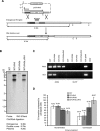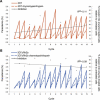Invasion by P. falciparum merozoites suggests a hierarchy of molecular interactions
- PMID: 16362075
- PMCID: PMC1315277
- DOI: 10.1371/journal.ppat.0010037
Invasion by P. falciparum merozoites suggests a hierarchy of molecular interactions
Abstract
Central to the pathology of malaria disease are the repeated cycles of parasite invasion and destruction of human erythrocytes. In Plasmodium falciparum, the most virulent species causing malaria, erythrocyte invasion involves several specific receptor-ligand interactions that direct the pathway used to invade the host cell, with parasites varying in their dependency on these different pathways. Gene disruption of a key invasion ligand in the 3D7 parasite strain, the P. falciparum reticulocyte binding-like homolog 2b (PfRh2b), resulted in the parasite invading via a novel pathway. Here, we show results that suggest the molecular basis for this novel pathway is not due to a molecular switch but is instead mediated by the redeployment of machinery already present in the parent parasite but masked by the dominant role of PfRh2b. This would suggest that interactions directing invasion are organized hierarchically, where silencing of dominant invasion ligands reveal underlying alternative pathways. This provides wild parasites with the ability to adapt to immune-mediated selection or polymorphism in erythrocyte receptors and has implications for the use of invasion-related molecules in candidate vaccines.
Conflict of interest statement
Figures





References
Publication types
MeSH terms
Substances
Grants and funding
LinkOut - more resources
Full Text Sources
Molecular Biology Databases

